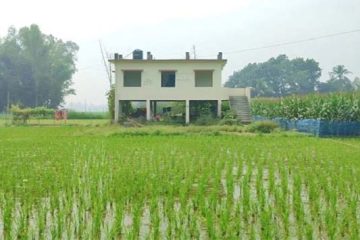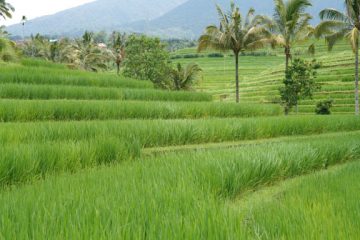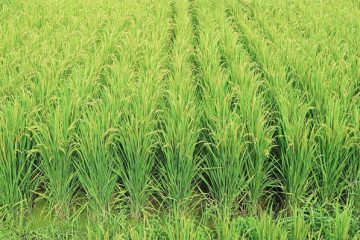 The coming of Kalbaishakhi (Nor’wester) is welcomed by the biggest secular festival of Bangladesh, Pahela Baishakh. Named after the star ‘Bishakha’, in line with the names of other Bengali months also named after constellations, romanticised notions of Baishakh were embedded in the hearts of millions, primarily due to Rabindranath Tagore’s love for the month. Pahela Baishakh is a day that sees countless celebrations all across Bangladesh and worldwide, wherever Bengalis have thrived. Over the years the festival has become synonymous with certain images. On the first day of the Bangla year 1418, we take a look at these elements that go a long way in defining this spectacular celebration.
The coming of Kalbaishakhi (Nor’wester) is welcomed by the biggest secular festival of Bangladesh, Pahela Baishakh. Named after the star ‘Bishakha’, in line with the names of other Bengali months also named after constellations, romanticised notions of Baishakh were embedded in the hearts of millions, primarily due to Rabindranath Tagore’s love for the month. Pahela Baishakh is a day that sees countless celebrations all across Bangladesh and worldwide, wherever Bengalis have thrived. Over the years the festival has become synonymous with certain images. On the first day of the Bangla year 1418, we take a look at these elements that go a long way in defining this spectacular celebration.
Tepa Putul
Perhaps the oldest toy, dolls are not just for children; they often symbolise prosperity and are considered sacred. In all likelihood, Tepa Putul or indigenous clay dolls have their origins in the images of deities, made by potters. They are shaped by hand, dried in the sun and fired in kilns. Originally, there were never painted.
Tepa Putul were not made for sale. These dolls were generally gift items or for sacrifice. At some point, artisans faced financial crises and began looking for alternative means of earning money. Thus they started selling these dolls. Now the dolls are painted in yellow, red, green and black.
Tepa Putul are mainly made in Mymensingh, Chittagong, Dinajpur, Rangpur, Manikganj and Faridpur. Most potters live in close proximity to rivers where silt is easily available.
Nagor Dola
Approaching a Baishakhi mela in any district of the country, one is likely to hear a loud and incessant creaking, somewhat resembling the wailing of a monster in some movie. What makes that sound is Nagor Dola, a major attraction at a Baishakhi mela. In its function, it may well resemble a small Ferris wheel, but Nagor Dola is powered solely by human exertion.
To give a simple account of its mechanism, one must begin with the two colourful wooden poles that are set upright in the ground to hold an axle, on which two pairs of massive shafts are positioned. As the two pairs of parallel shafts cross each other in the middle, they also get balance of a rotor mounted on an axle. Four wooden carriages, each large enough to contain around four people, are hung from four axles placed on the ends of the shafts.
At a Baishakhi mela, a couple of men are usually seen rotating the shafts by pushing the carriages. The vividly painted poles, carriages, shafts and the creaking sound give the whole contraption an appearance extravagant enough to astound children.
Riding a Nagor Dola is as exciting and wonderful as the apparatus appears to be. Sitting in a carriage, while the shafts are being rotated at a high velocity, the riders experience a tremendous centrifugal force that seems powerful enough to throw them to outer space. It also gives the strange sensation of
defying gravity.
Panta Ilish
Pahela Baishakh celebrations, initiated by Chhayanaut, at the Ramna Botomul began in the country in the 1960s. The Panta-Ilish tradition originated from there. Celebrity chef Keka Ferdousi says Panta (rice soaked in water) came straight from the homes of farmers; easy to make when nothing else is available. The abundance of Ilish in this delta made the combination of Panta-Ilish a winner — something both the rich and poor can afford on Pahela Baishakh. Bengalis believe that a good meal on the first day of the year will bring good luck in the coming days. Keka Ferdousi adds that as large mela (fairs) became a tradition in the capital in post-Liberation War Bangladesh, Panta-Ilish turned into a must-have on the refreshment menu.
Shokher Hari
Shokher Hari is a term that traces its origins to Rajshahi. Rajshahi and Chapainawabganj are known for Shokher Hari.
“A number of families at Bangalpara and Bayapara of Rajshahi district as well as Tegoria of Chapainawabganj make these beautiful clay pots.
“Ornamentation is an important aspect of the hari — usually featuring a mingling of yellow and white. Some recurrent motifs of Shokher Hari are fish, birds, water lilies and paddy. It is believed that the hari brings good luck to the family,” said Nisar Hossain, Professor of Drawing and Painting Department, Faculty of Fine Arts, University of Dhaka.
Because of this belief, Shokher Hari has made its place in the Baishakhi celebration. The hari is often found at religious and secular festivals. It often features mythological themes and comes in different sizes and shapes.
Mask
A mask is an article normally worn on the face, typically for protection, disguise, performance or entertainment. Masks have been used since antiquity for both ceremonial and practical purposes and have attained vast popularity for decades in Bangladesh, especially on Pahela Baishakh.
Masks are used almost universally and maintain their power and mystery both for their wearers and their viewers. The image of juxtaposed comedy and tragedy masks are widely used to represent the performing arts.
Artist Saidul Haque Juise, one of the pioneers of reviving popularity of masks in Bangladesh, is well-known for his papier-mâché masks, often seen at Pahela Baishakh rallies or Mangal Shobhajatra.
“Keeping Bangaliana (Bengaliness) in mind, masks should be made meaningful so that traditional tastes find new magnitude,” says the artist.
Putul Naach
The unprecedented growth of consumerism and the penetration of western and Indian entertainment into our culture have diminished the popularity of traditional entertainment like putul naach or puppet theatre in the country.
Puppets, usually made of clay, paper, wood, plastic and cloth, represent animals or humans. In a putul naach, puppeteers entertain the audience by making the puppets replicate actions. Enactment of popular tales by puppets amuses the audience much like a theatre troupe. Watching the puppets come alive through the craft of a puppeteer is entertaining to children and grown ups alike.
Talking about this art form, Mustafa Monwar, noted cultural personality of the country, also known as the ‘Puppet King’, says, “All art forms can be combined in puppetry — painting and oratory skills, for example.”
Though putul naach used to be hugely popular in Bangladesh and was part of the entertainment at most celebrations, including Pahela Baishakh, the art form is gradually losing its popularity. Fortunately, in recent years there have been attempts at resurrecting putul naach among children in urban areas.
Monwar’s adaptation of the American puppet show “Sesame Street” is now a favourite among Bangladeshi children.
There are puppet troupes in various districts in the country, who continue to entertain crowds at festivals like Pahela Baishakh.
Red & White
From children to the elderly, everyone knows that Pahela Baishakh means wearing red and white. Although now fashion houses are producing attires featuring other colours as well for the festival, red and white still occupy a special place in the Baishakhi celebration. The question is how did this tradition begin?
In all likelihood, no extensive research has been carried out on this subject as the experts have varied opinions. “Tradition is a phenomenon created over a course of time,” says artist Mustafa Monwar. The veteran artist believes that the rural tradition of using primary colours such as red would be the main reason behind this trend.
“Red symbolises prosperity and white stands for purity,” says Monwar. The artiste also says that the tradition originated long ago but Chhayanaut’s musical programme and Charukala’s rally on Pahela Baishakh have further popularised it.
Folk researcher Saymon Zakaria believes that like many other pioneering endeavours, women of the Jorashako Tagore family might have initiated this tradition. Zakaria thinks that the trend of wearing red and white is more apparent in the cities than in rural areas.
Artist Abdus Shakoor Shah, who mainly works on folk motifs, says that the phenomenon may have occurred because city artists took ideas from the rural artisans’ use of bright colours such as red. “Considering the heat of Baishakh they also opted for white as a soothing colour,” says Shah.
Mishti
Those behind the art of making mishti (sweets) are known as moira or modok. The history of the modok also holds the origin of deshi sweet-making techniques. Laddu is considered to have originated before other sweets in this part of the world. The Baishnab community supposedly developed the art of making chhana based sweets. The arrival of Madan Mohan Jiu in Kolkata marked a rise in the popularity of chhana. The traditional menu of sweets for farmers included gur-chira and coconut. But since the advent of the 19th century, different areas in the then undivided Bengal attained reputation for their unique sweets. Natore became famous for its Kachagolla; Comilla for its Roshmalai; Gouronodi’s yogurt; Netrokona’s Balish mishti, Tangail for Chamcham, Chapainawabganj and Rajshahi for Roshkodom and many more. Roshogolla — arguably the most popular among sweet connoisseurs — gave birth to several varieties of sweets, such as Rajbhog, Roshmalai, Khirmohon, Indranibhog, Lady Kenny and Chhanamukhi. Monda is a version of the popular Shondesh. Bengalis are known for their hospitality and always take sweets when visiting friends and relatives. Feasting on sweets on the first day of the year is an integral part of the celebration.
Dhol
If there is any festival that unites all Bengalis, it is Pahela Baishakh. Heralding the day are the pulsating beats of Bengali dhol (drum) with the timeless song “Ami Takdum Tak Dum Bajai Bangladesh-er Dhol” (popularised by Sachin Dev Burman).
Bengali dhol is a must have instrument in folk songs such as Jari, Shari and Kobi Gaan. During Chaitra, the last month of the Bengali year, dhulis (dhol players) all over the country wake up from their cultural hibernation of sorts. Pahela Baishakh is always the busiest time for them and they are booked much in advance by numerous cultural organisations.
“Dhak comes first, then dhol. No traditional festivity like Chaitra Shangkranti, Sangkirton, Borshi Banam or Pahela Baishakh, is complete without dhol. When the dhol ushers in the new day, all Bengalis, regardless of caste and creed, get united. After all, we are the sons and daughters of the same mother, Bangladesh,” says noted dhuli, Dasharath Das.
Dhol is one of the oldest musical instruments of Bengal and is made of a big wooden shell with two parchment heads tightened by leather straps. It is hung in a slanted position on the shoulder when played.
The dhol dates back to 15th century. It was probably introduced to the Indian subcontinent by Persians (dohol or duhul). The evidence of this is found in “Ain-i-Akbari”, the third volume of the “Akbarnama” (containing information regarding Mughal Emperor Akbar’s reign), which describes the use of duhul in the royal orchestra. From North India, use of dhol spread to other parts of the subcontinent.
Haal Khata
The tradition of opening haal khata — which was on the verge of extinction in the urban areas — is now being resurrected and gaining popularity among young entrepreneurs. Until recent times, only shops in the Old Dhaka area kept the tradition alive. However, more and more people are opening new account books on Pahela Baishakh after closing the previous ones. This year will be no different in the Old Dhaka areas. Most arot or wholesale stores have taken on a festive look, while invitations have been sent out to all the regular buyers. Festivities are most vibrant among traders from Shakhari Bazar, Shyam Bazar and Bangla Bazar as they print invitation cards and arrange sweets and Biryani to serve to their clientele on the day. Muslim traders usually hold milad, while Hindu traders offer puja to begin the haal khata celebrations.
Courtesy of The Daily Star






